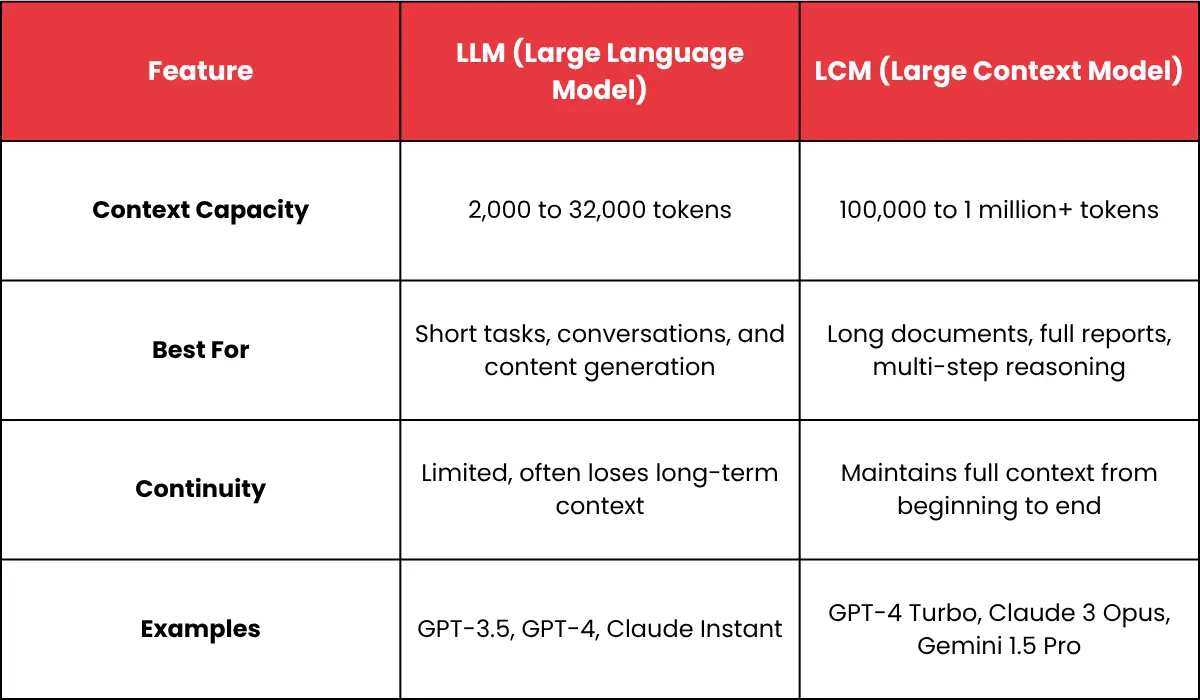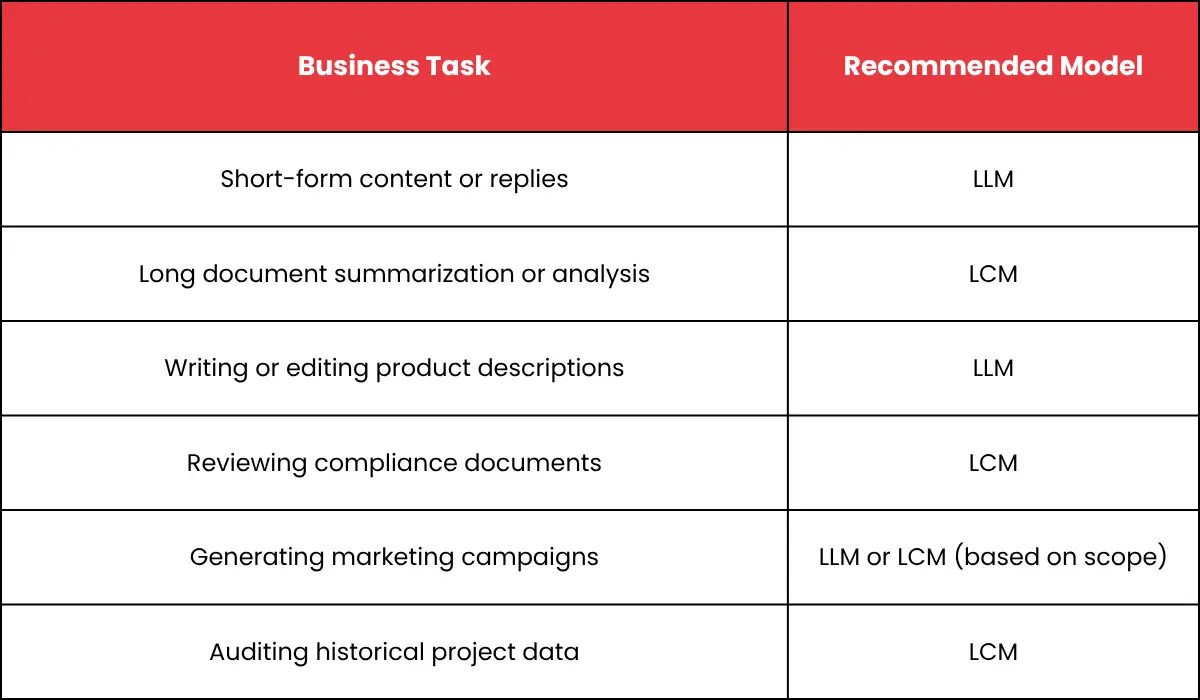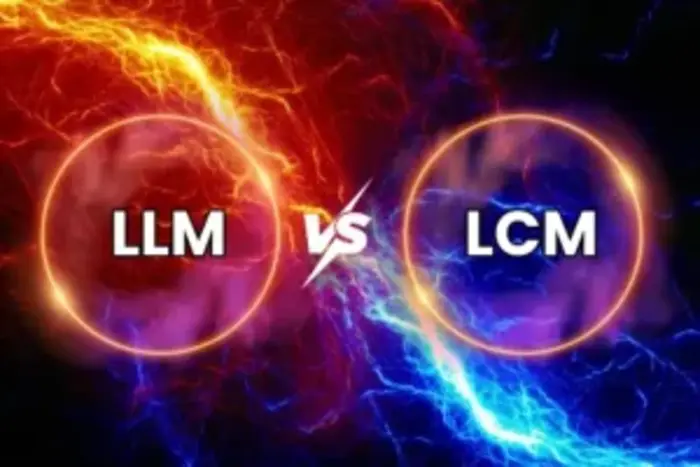AI is changing the rules of business, impacting both how companies function and how they compete. From automating workflows and analysing data to improving customer experiences and reducing costs, AI is proving to be a powerful enabler of innovation and efficiency.
Large Language Models (LLMs) are at the forefront of the AI revolution- intelligent systems built to understand and generate human-like language with exceptional accuracy. However, a new evolution in this space is gaining momentum: the Large Context Model (LCM).
Although LLMs and LCMs are closely related, understanding the difference between them is critical for business leaders looking to implement AI in meaningful, scalable ways. In this article, we will explore what separates these two models, how their capabilities differ, and why Large Context Models may represent the next major leap forward in AI applications for enterprises.
What Is a Large Language Model (LLM)?

At the core of the AI revolution are Large Language Models (LLMs)- highly advanced tools that excel at understanding and producing natural language. It learns the structure, semantics, and usage of language in order to perform a variety of tasks such as:
- Text generation
- Summarization
- Sentiment analysis
- Translation
- Answering questions
- Code generation
Businesses around the world are already leveraging LLMs to automate tasks, generate marketing content, enhance communication, and improve customer service. Yet, for all their capabilities, traditional LLMs face a key limitation- a limited context window.
The Limitation of Context in LLMs
The context window refers to the amount of input a model can consider at one time. Traditional LLMs typically handle between 2,000 to 32,000 tokens. Tokens are pieces of text, such as words or characters, and this limitation affects how much content the model can process in a single query.
For example, if you need to analyze a 100-page legal contract or a year’s worth of emails, a standard LLM would require you to break that content into smaller chunks. This introduces risk- important context can be lost, and continuity can break down.
This is where Large Context Models (LCMs) offer a significant improvement.
What Is a Large Context Model (LCM)?

A Large Context Model is an advanced version of a Large Language Model, specifically designed to handle significantly larger volumes of input, often between 100,000 and 1 million tokens.
This means a Large Context Model can analyze and interpret much more data in a single pass. It can read entire books, legal documents, codebases, or multi-part conversations while retaining the full context throughout the analysis. This is especially useful for business processes that involve large and complex documents or long-term data records.
Examples of LCM-enabled models include:
- GPT-4 Turbo by OpenAI – designed to handle up to 128,000 tokens
- Claude 3 Opus by Anthropic – built to process up to 200,000 tokens
- Gemini 1.5 Pro by Google – supports context windows of up to 1 million tokens
LLM vs. LCM: What Is the Difference?

Why Should Business Leaders Care?
For enterprises dealing with complex operations, compliance-heavy industries, or large volumes of unstructured data, the ability to process more information in one pass is not just a technical upgrade- it is a business advantage.
Here are some high-impact business scenarios where large context models excel:
1. In-Depth Document Analysis
LCMs can review and summarize lengthy legal agreements, compliance reports, technical manuals, or financial records in one go, reducing the need for manual review and the risk of human error.
Example: A legal team can analyze a 150-page contract and receive a breakdown of key clauses, risks, and red flags- all within seconds.
2. Comprehensive Customer Insight
With access to full customer interaction histories, feedback, support tickets, and CRM data, LCMs can identify patterns, predict needs, and recommend actions with much greater precision.
Example: A customer service team can use an LCM to offer personalized responses based on an entire year’s worth of customer data.
3. End-to-End Code Review and Optimization
For software companies or IT teams, LCMs can read and interpret entire repositories of code, allowing for smarter debugging, faster onboarding, and more efficient code optimization.
Example: An engineering lead can prompt an LCM to identify performance bottlenecks across thousands of lines of code.
4. Advanced Business Intelligence
LCMs can generate reports, streamline internal communication, and analyze market research to empower leaders with data-driven insights.
Example: A strategist can ask an LCM to compare three years of annual reports and investor communications to uncover evolving priorities and risks.
Are LCMs Replacing LLMs?
Not entirely. Large Context Models (LCMs) build upon traditional LLMs- they enhance, not replace them. LLMs are still suitable for lightweight and transactional tasks- composing emails, drafting social media posts, and answering short queries.
However, for organizations seeking to maximize AI’s impact on core business operations, LCMs represent the next level of performance.
Choosing the Right Model for Your Business

Conclusion: A Smarter, More Context-Aware Future
The shift from LLMs to LCMs is more than just a technological improvement; it is a fundamental change in how AI can support business at scale. By processing entire documents and datasets in one instance, Large Context Models enable deeper understanding, greater consistency, and more accurate decision-making.
For business leaders, adopting LCM-powered tools can lead to enhanced productivity, faster time to insight, and more informed strategic actions.
If your organization is ready to evolve beyond the limitations of traditional AI, Large Context Models offer the clarity and capacity needed to navigate complexity with confidence.
Want to implement AI in Your Business?
Our AI experts can help you identify where LCMs and LLMs fit best into your workflows and technology stack. Connect with us today to begin building a smarter, context-aware future.



